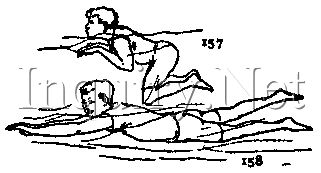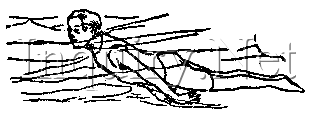By Dan Beard

Figs. 154-156.
The Bull-Frog Kick and the Broad Stroke
(Poses Purposely Exaggerated)
Every Pioneer must know how to swim, and it is the duty of the officers of the Fort to instruct the other members in the art. Figs. 154. and 157 show the first position assumed in the common method of swimming. Figs. 155 and 158 show the second position, where the arms have been shot out in front ready to make a sweeping stroke, with the hands used as oar blades (Fig. 159), until they are brought to the sides, as in Figs. 156 and 160. In some of these diagrams the positions have been purposely exaggerated to make them more intelligible.

Figs. 157-158.
Side View of Breast Stroke and Bull-Frog Kick

Fig. 159.
Still Another View of Breast Stroke

Fig. 160.
Another View--Same Stroke as Preceding

Figs. 161-168.
Various Strokes and Vogues
Fig. 161 shows the way to tread water. Fig. 162 is a group of Eastern boys swimming hand over hand. Fig. 163 shows the English racing overhand stroke.
Fig. 164 is the most difficult stroke of all to learn; it is known variously as the racing stroke, the East Indian stroke, or the trudgeon. In this the swimmer's head is beneath the surface most of the time, and his only chance to catch a breath of air is in the part of the stroke when the hand is coming back and just as the right elbow passes his face.
In the trudgeon one swims mostly upon one side. The overhand movement is used, first one arm and then the other being raised over the water. When the left arm is extended above the head the legs are spreading apart for a kick; when the left arm is brought down the legs are extended and then brought together with a sharp kick called the scissors kick. The right arm is in the meantime brought forward above the water, and as the right arm comes down the left arm is thrust out or extended. The scissors kick is made every other stroke by spreading the legs (Fig. 165), and then bringing them together with a quick movement called a "snap."
Figs. 166, 167, and 168 show another racing stroke, but this is the celebrated crawl, an American improvement on the Australian, Indian, and English method, and claimed to be the fastest mode of swimming yet invented.
Fig. 166 shows the first position, an easy reach with the left arm and a short thrash with the feet. In Fig. 167 the arm has been brought back with elbow high, much like the motion of a dog's front legs when it is digging out a woodchuck. Fig. 168 shows the end of the stroke with hand brought back to him.

Fig. 169.
Dog Fashion
Fig. 169 is the old reliable dog fashion. In this method the arms move like the front legs of a dog, and the swimmer's feet kick in any old way to keep him from sinking.

Fig. 170.
The Arm Hold
All boys who teach themselves to swim unaided learn first to swim the dog fashion. Fig. 170 shows how a good swimmer may, by grasping an exhausted person's arm and swinging the person's head on the swimmer's shoulder, paddle with one hand until he reaches the shore.

Fig. 171.
The Neck Hold
Fig. 171 shows what is called the neck hold. Here the rescuer swims on his back, using his legs to propel his body through the water, his hands on the neck of the exhausted or drowning comrade being prevented from slipping off by the projection of the jaw-bones.
There is only one way to learn to swim, and that is to get into safe water with experienced companions and swim.
Then, after you have gained confidence in yourself, you may make some use of articles written on this subject and the diagrams here given will be of some service to you. These notes, however, are only hints and do not pretend to teach the reader how to swim; they serve, however, as an appropriate introduction to the following diagrams and tell